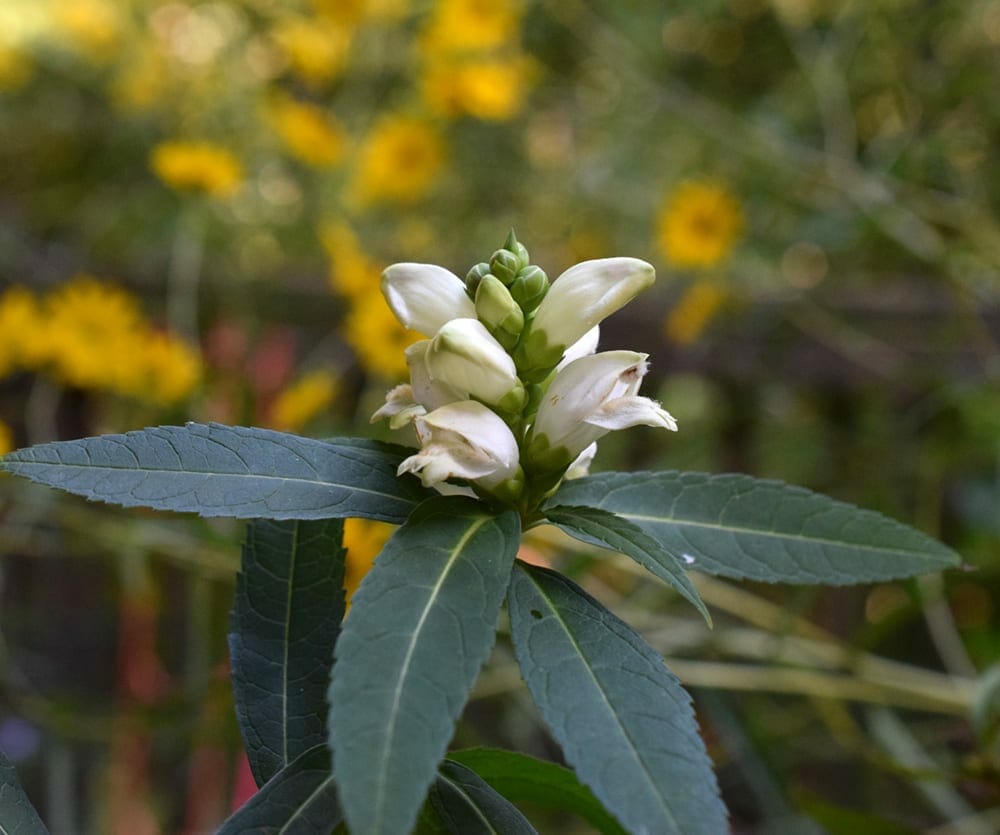Vote for the GNPS 2020 Plant of the Year!
Each year, we celebrate one special native plant by selecting it as GNPS Plant of the Year (POY). The six nominated plants are featured below. POY online voting is EASY. Just go to the voting page*, click to make your selection, and press “Submit.” (If you are not already logged in, you will be prompted to do so before the voting page appears.) Online voting will remain open from Tuesday, Oct 22 at 7 p.m. until Monday, Nov 11 at 6 p.m. Members who don’t vote online are welcome to vote in person by paper ballot at the November 12 meeting. The last few years have seen some really close contests, with only a few votes separating the winner from the runner up. YOUR VOTE MATTERS! So get in there and pick the plant you think is best for POY 2020!
*If the link to the voting page above doesn’t work for you, try copying this in your browser: https://gnps.z2systems.com/survey.jsp?surveyId=6&
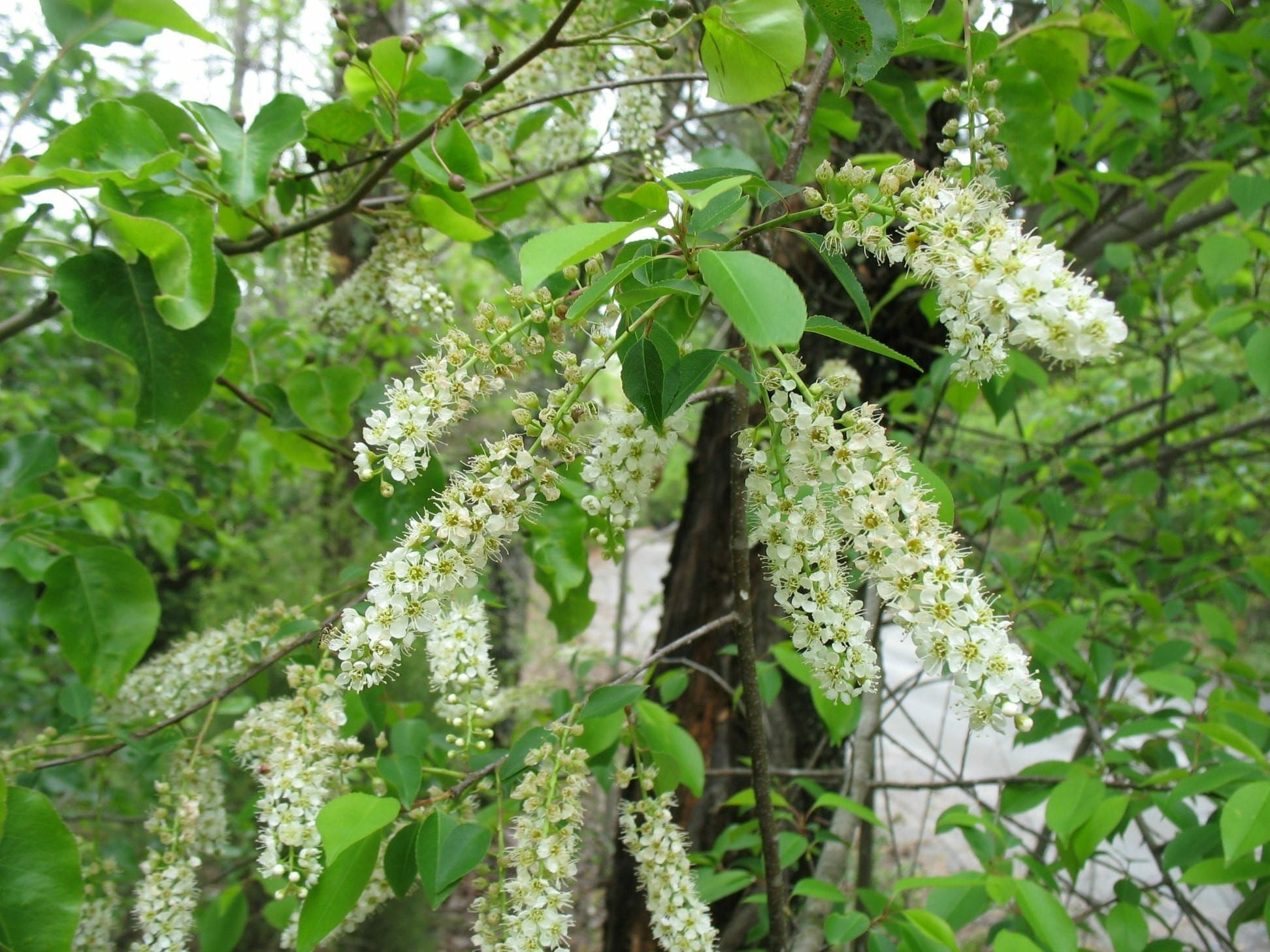
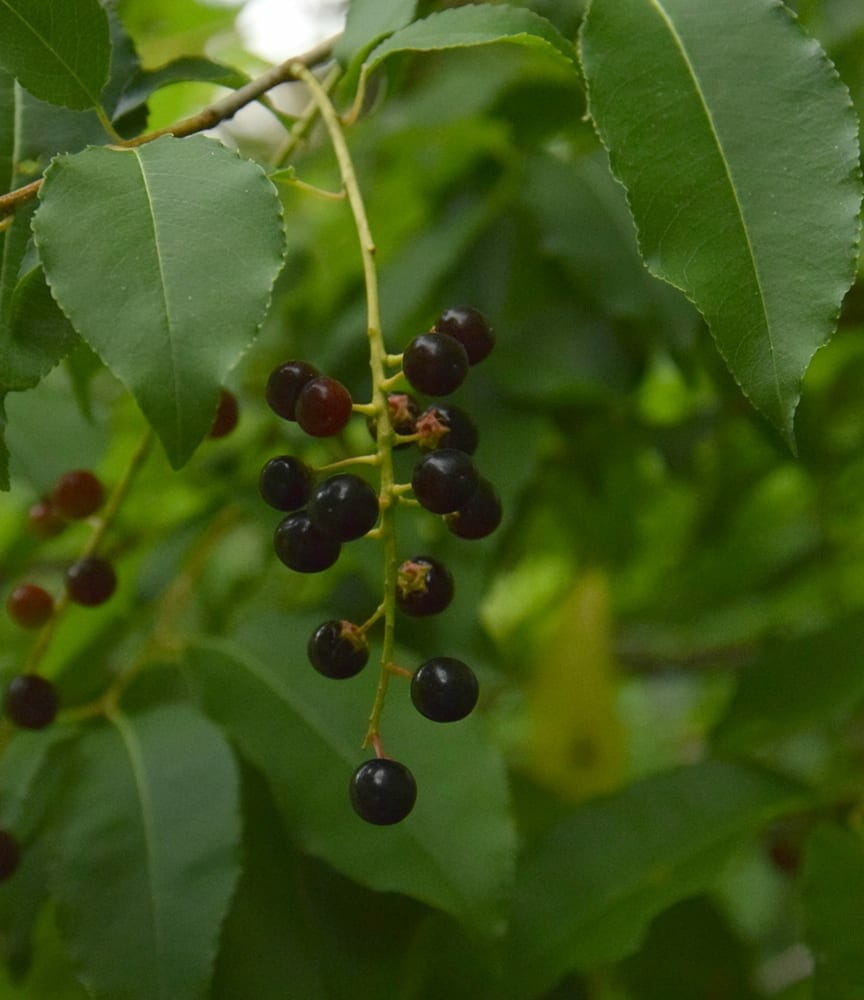
Black cherry
Scientific name: Prunus serotina
Common name: Black cherry; rum cherry
Family: Rosaceae
Plant type: Tree
Black cherry (Prunus serotina) is of great ecological importance, both as a larval host to numerous caterpillars and as an animal food source. Over 400 insect species utilize this plant as part of their life cycle. In the spring, it produces a profusion of dangling, lacy, fragrant, white blossoms–a pollinator bonanza. In autumn, small, pea-sized, red-to-almost black fruits feed birds and many mammals, from mice to bears. This tree is also significant economically. Its strong, close-grained hardwood is utilized widely in cabinetry, paneling, gunstocks, musical instruments, and other fine woodworking items. Most commonly found in forest coves, this fast-growing species can grow over 100’ tall, with a spread of up to 70’. Its leaves are shiny and simple, and its young bark is smooth, with rows of horizontal lenticels. As it matures, black cherry bark becomes dark and flaky, resembling pine bark. Most parts of the plant are poisonous; however, the inner bark is valued in making cough medicine, and the fruit is edible, albeit bitter.
Credits: Text by Valerie Boss. Photos by Ellen Honeycutt.
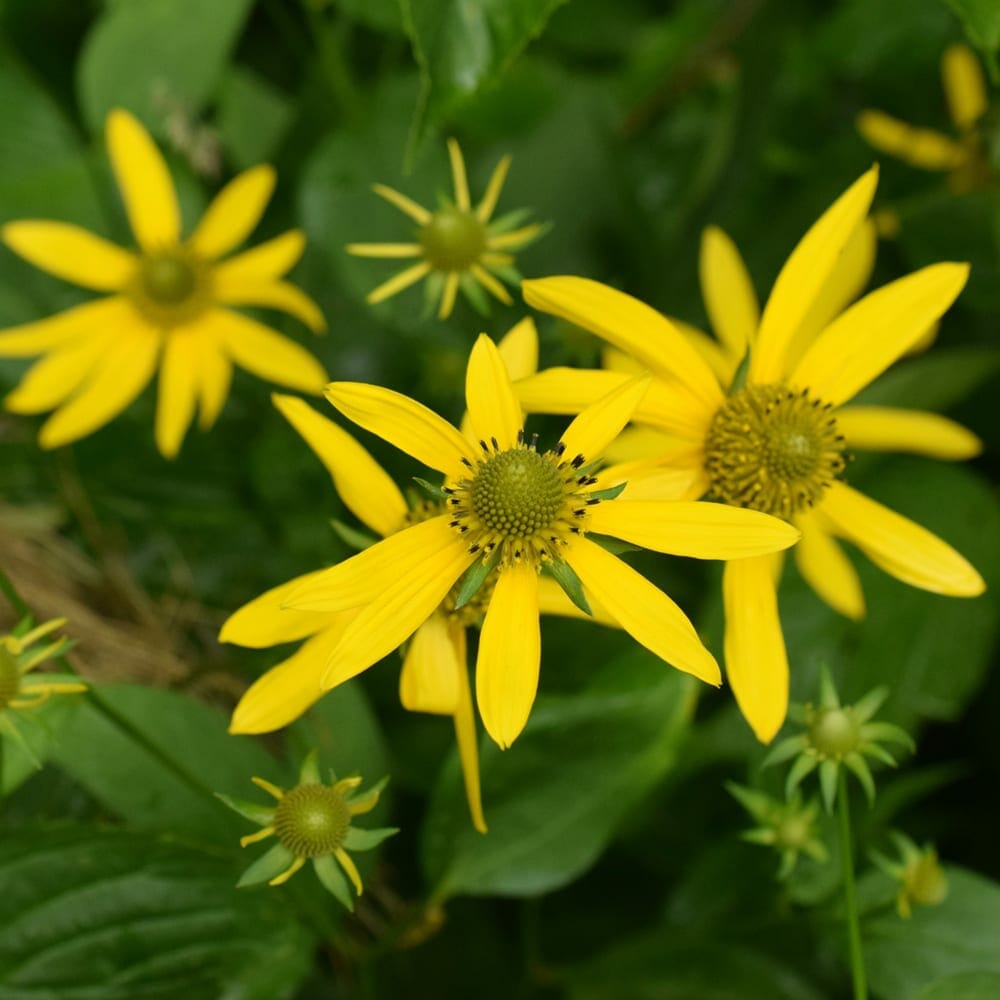
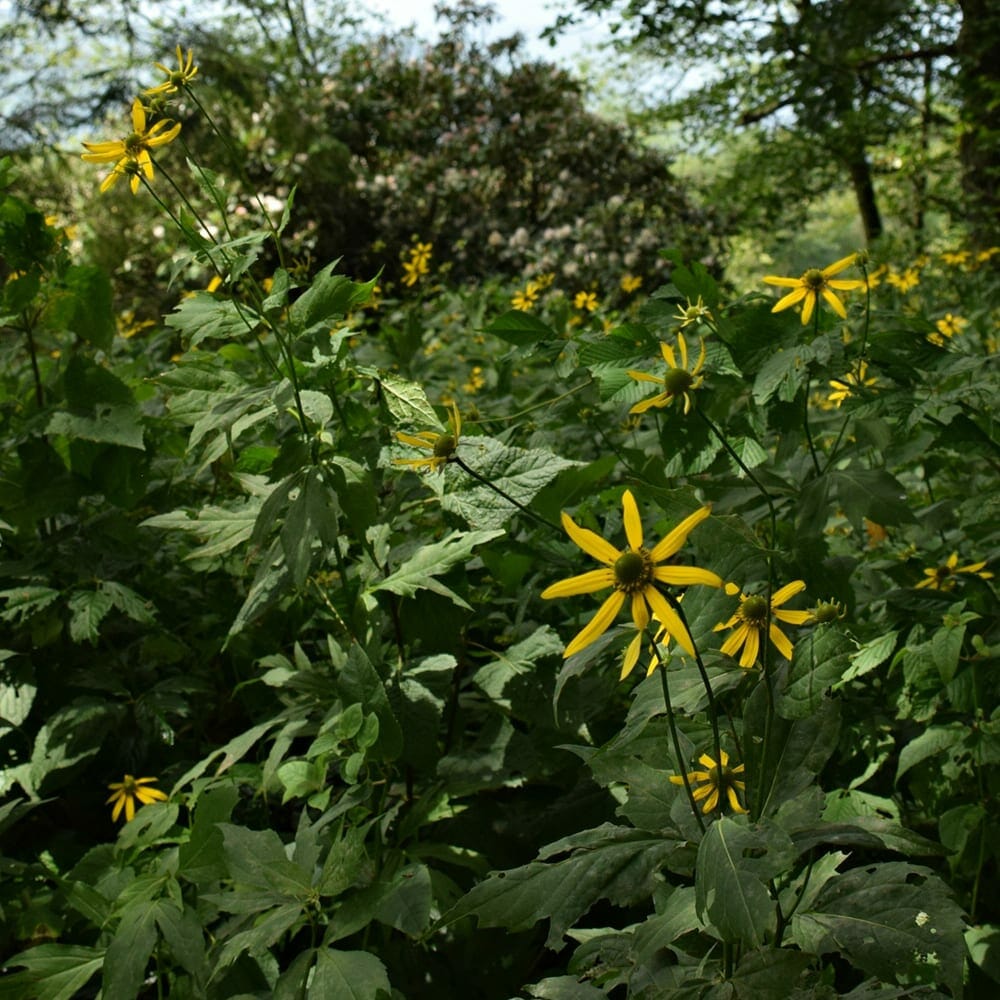
Cutleaf coneflower
Scientific name: Rudbeckia laciniata
Common name: Cutleaf coneflower; green-headed coneflower
Family: Asteraceae
Plant type: Perennial
Cutleaf coneflower (Rudbeckia laciniata) thrives in sunny wetlands, where its bright yellow composite flowers make a cheery addition to the summer landscape. It typically grows to heights of 5-10 ft, and is often described as “lanky”. Cutleaf coneflower can easily be distinguished from the many other yellow composites by its opposite, large (up to 12” long and 10” across), grey-green leaves, most of which have 3-7 deeply dissected lobes with toothed margins. A basal rosette of smaller dissected leaves may persist through the winter, even after the rest of the plant has died back. From July through early October, slightly drooping blooms (2-4” around) appear at the ends of the stems, each comprised of 6-16 yellow ray flowers with a protruding central disk flower. Unlike other Rudbeckias, this species’ flower center is green; hence the alternative common name: “green-headed cone flower”. Cutleaf coneflower is easy to grow in the garden, and spreads easily by self-sowing and rhizomes. Although it prefers moist soil, it can tolerate dry conditions once established. It is attractive to butterflies, and goldfinches love to eat its seeds.
Credits: Text by Valerie Boss. Photos by Ellen Honeycutt.
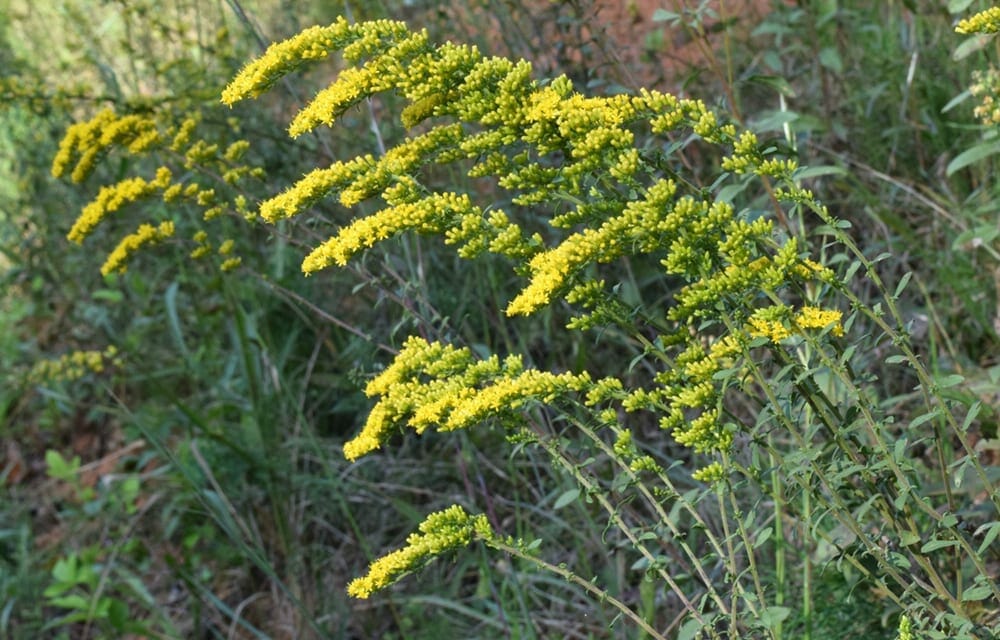
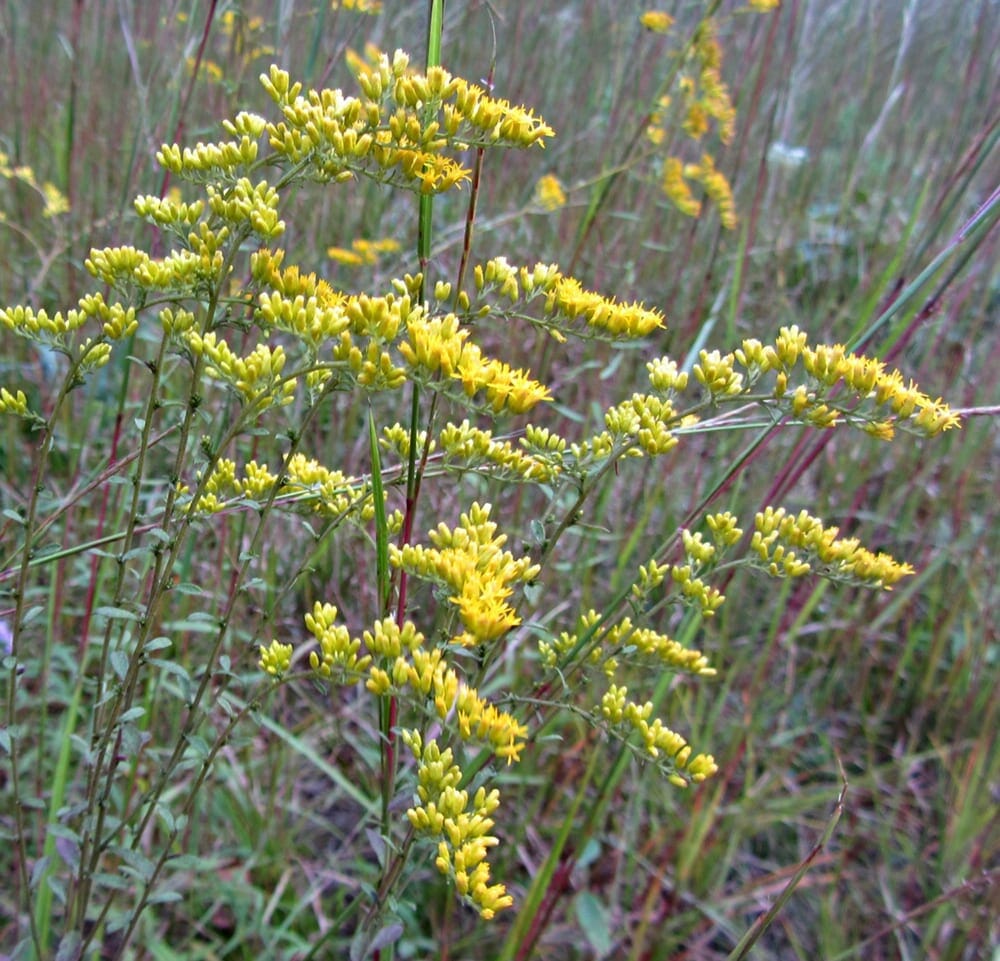
Gray goldenrod
Scientific name: Solidago nemoralis
Common name: Gray goldenrod
Family: Asteraceae
Plant type: Perennial
Gray goldenrod (Solidago nemoralis) is a hardy perennial that grows in all ecoregions of Georgia, including Ridge and Valley, Blue Ridge, Piedmont, and Coastal Plain. Sometimes called dwarf goldenrod, it typically grows to about a foot tall; however, it can reach 30” under optimal conditions. The stems of gray goldenrod are unbranched, topped on the upper side by a wand-like cluster of brilliant yellow flowers. When in heavy bloom, they have a tendency to nod. Leaves are silver-gray, elliptical or narrowly lanceolate, and up to 4” long and ¾” across, becoming smaller as they ascend the stem. In addition, the middle and upper leaves sport clusters of tiny secondary leaves growing from the axils. This is a very versatile plant, suitable for borders, wildflower meadows, and pollinator gardens. It grows in both sun and shade, thrives in poor soils, tolerates drought, does not spread aggressively, and is attractive to insects. A wide variety of bees, wasps, flies, moths, and butterflies, including migrating monarchs, feed on its pollen, nectar, and foliage. The plant can be propagated by seed or by division of mature plants, which occasionally form clonal colonies.
Credits: Text by Valerie Boss. Photos by Ellen Honeycutt.
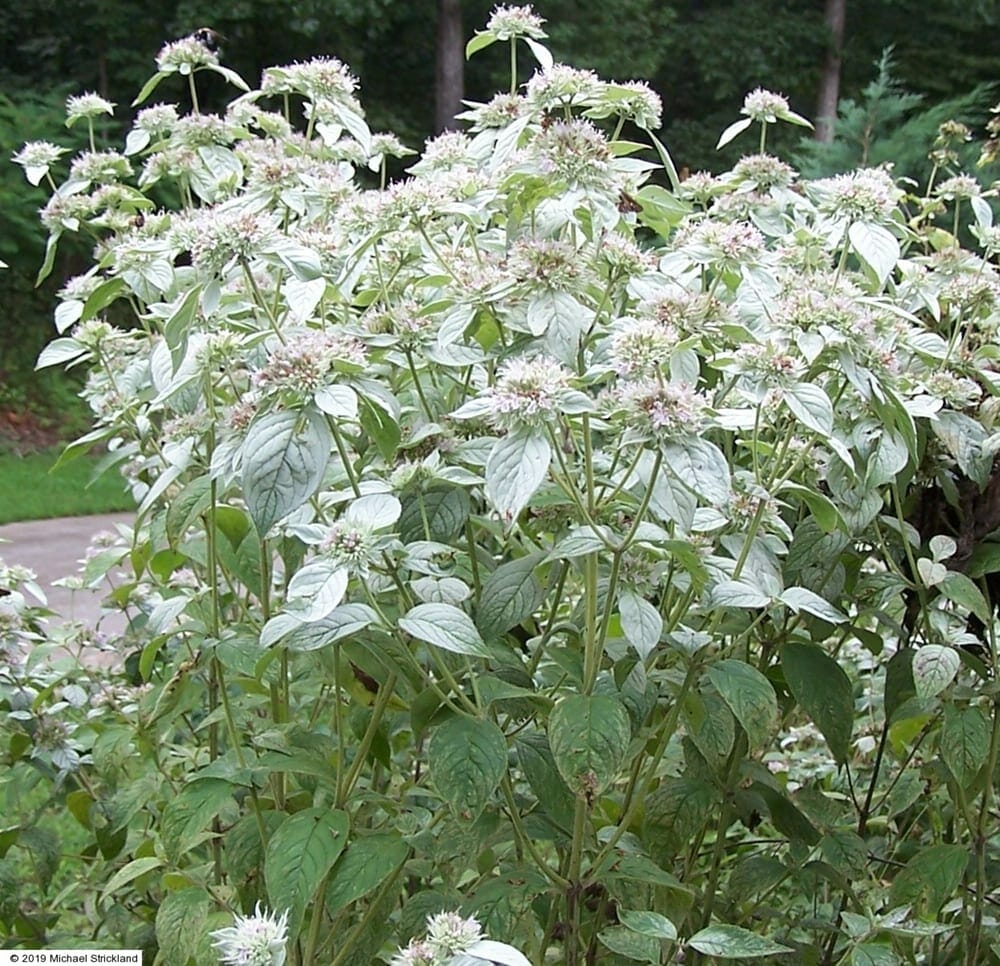
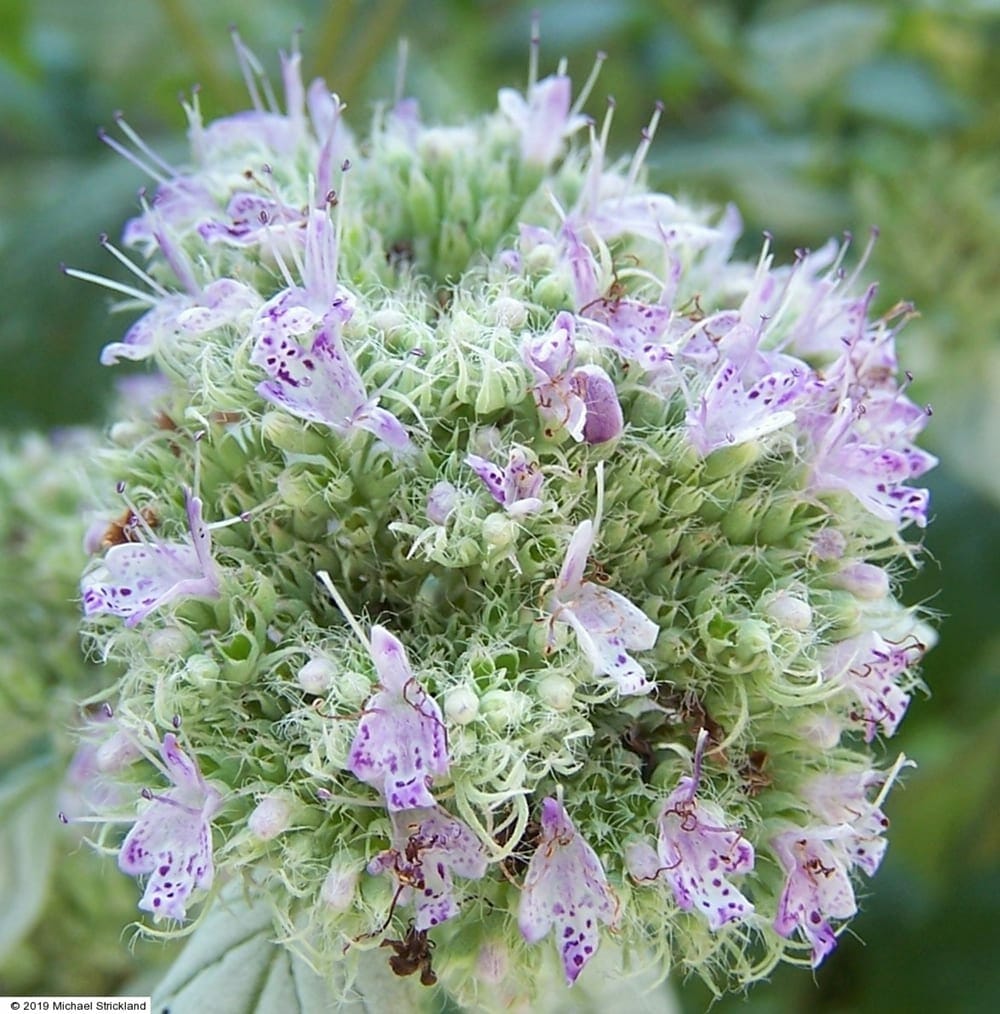
Southern mountainmint
Scientific name: Pycnanthemum pycnanthemoides
Common name: Southern mountainmint
Family: Lamiaceae
Plant type: Perennial
Southern mountainmint (Pycnanthemum pycnanthemoides) is native to fields and open woodlands throughout Georgia. Thriving in full sun or partial shade, it grows 3-6’ tall, and has simple, opposite, lanceolate leaves. Both the leaf undersides and the stems are hairy. In summer and early autumn, Southern mountainmint looks like it has been frosted liberally with confectioner’s sugar, as its upper leaves are covered in short, curly white hairs that appear almost silvery in the sunlight. From June through August, each stem is topped by a head (about 1” across) of tiny, tightly clustered, irregularly shaped, white flowers with pinkish-purple markings. These flowers typically do not all open at the same time, but blossom here and there progressively over the flowerhead, attracting bees and butterflies throughout the summer. The plant is also a forage food for birds, which like its seeds. Mountainmints are in the Lamiaceae family, and have many characteristics in common with true mints: square stems, aromatic leaves, hardiness, drought tolerance, medicinal properties, and a tendency to spread. In the garden, give Southern mountainmint lots of room. It makes a beautiful background plant for shorter species with dark foliage or bright flowers.
Credits: Text by Valerie Boss. Photos by Michael Strickland, © 2019 Michael Strickland (reproduce only with permission).
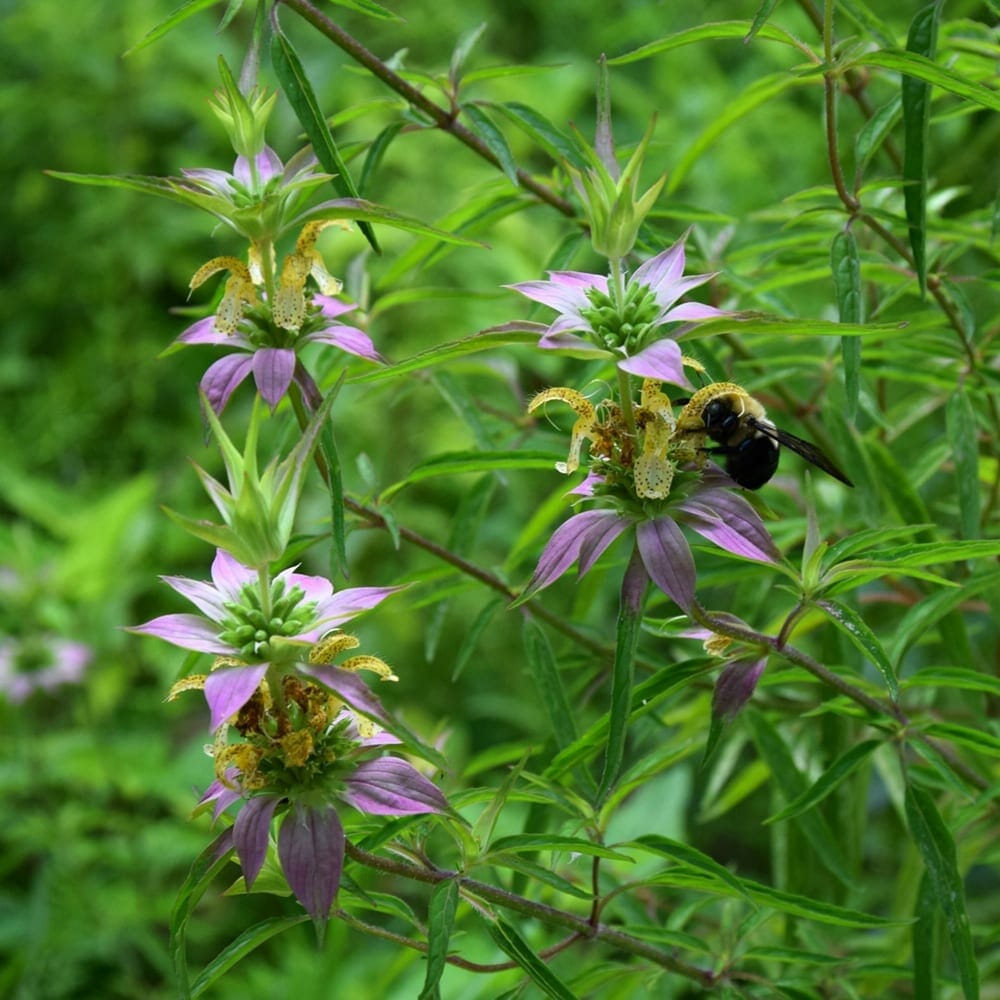
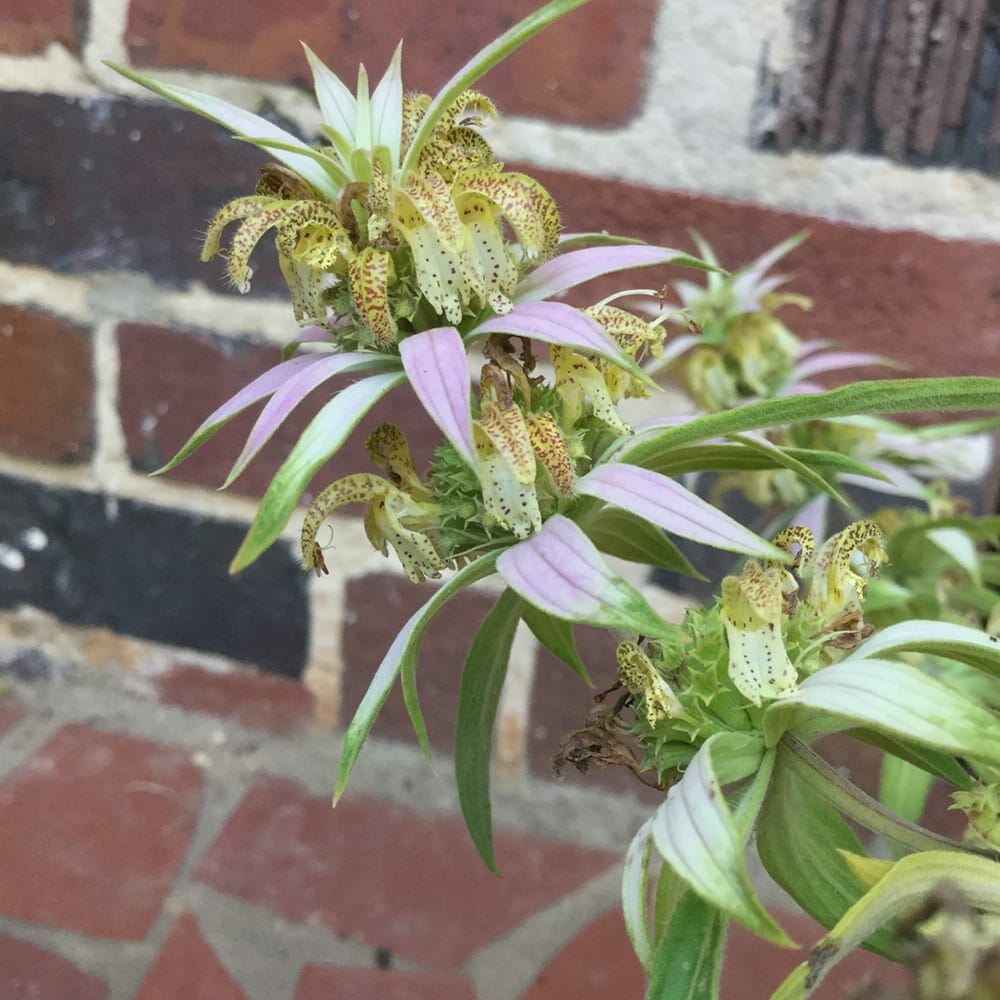
Spotted beebalm
Scientific name: Monarda punctata
Common name: Spotted beebalm; spotted horsemint
Family: Lamiaceae
Plant type: Perennial
Spotted beebalm (Monarda punctata) grows in dry, sandy soils, and is found in woodland margins and coastal plains. Its stems (2-3’ tall) are square, either simple or branched, and covered with soft hairs. Opposite leaves grow to about 3” long, and are lanceolate, toothed, and hairy. They are also highly aromatic, containing thymol, a compound also found in oregano. Spotted beebalm is a source of pollen and nectar for numerous bees, as well as wasps, sphinx moths and various butterflies. An easy plant to grow, the species is attractive to people, as well as insects. In summer, its showy flower heads are confections of whorled bracts and domes of under-curling, purplish-dotted yellow petals. The inflorescence pattern of the species is unusual: flower heads, each about 1” around, are stacked—one at the stem tip, and those below it encircling the stem. Bracts beneath the petal domes are pinkish-purple, and a bright green whorl of bracts crowns the terminal flower head. Like many members of the mint family, spotted beebalm is medicinal. The leaves may be used in teas to treat fever, aches and inflammation, and the essential oil has antibacterial properties.
Credits: Text by Valerie Boss. Photos by Ellen Honeycutt and Valerie Boss.
White turtlehead
Scientific name: Chelone glabra
Common name: White turtlehead
Family name: Plantaginaceae
Plant type: Perennial
White turtlehead (Chelone glabra) is a study in contrast, having deep green leaves and white or pinkish-white flowers. It typically grows to 2-3’ in height, and has square stems. Leaves are long (4-7”), narrow, and opposite, with a pronounced central rib and toothed edges. In summer, a spike of flowers forms at the top of the stem. Individual flowers bloom sequentially, from the bottom of the spike to the top. Each snapdragon-like blossom has 2 lips: an upper one with 2 lobes and a lower one with 3 lobes. Their resemblance to turtle heads lends them the species its name. Bees are attracted to white turtlehead, but only fairly large species are strong enough to push open the flower’s lips to reach the nectar inside. The plant’s primary insect visitors are bumblebees, but long-horned bees, although medium sized, also manage get inside the flower for a feast. White turtlehead is a host plant for the Baltimore checkerspot butterfly. The plant’s natural habitats are wetlands, swamps, and stream banks. A good choice for pondside plantings, white turtlehead loves wet feet, and will grow in sun or shade, as long as the soil is kept moist.
Credits: Text by Valerie Boss. Photos by Ellen Honeycutt.

